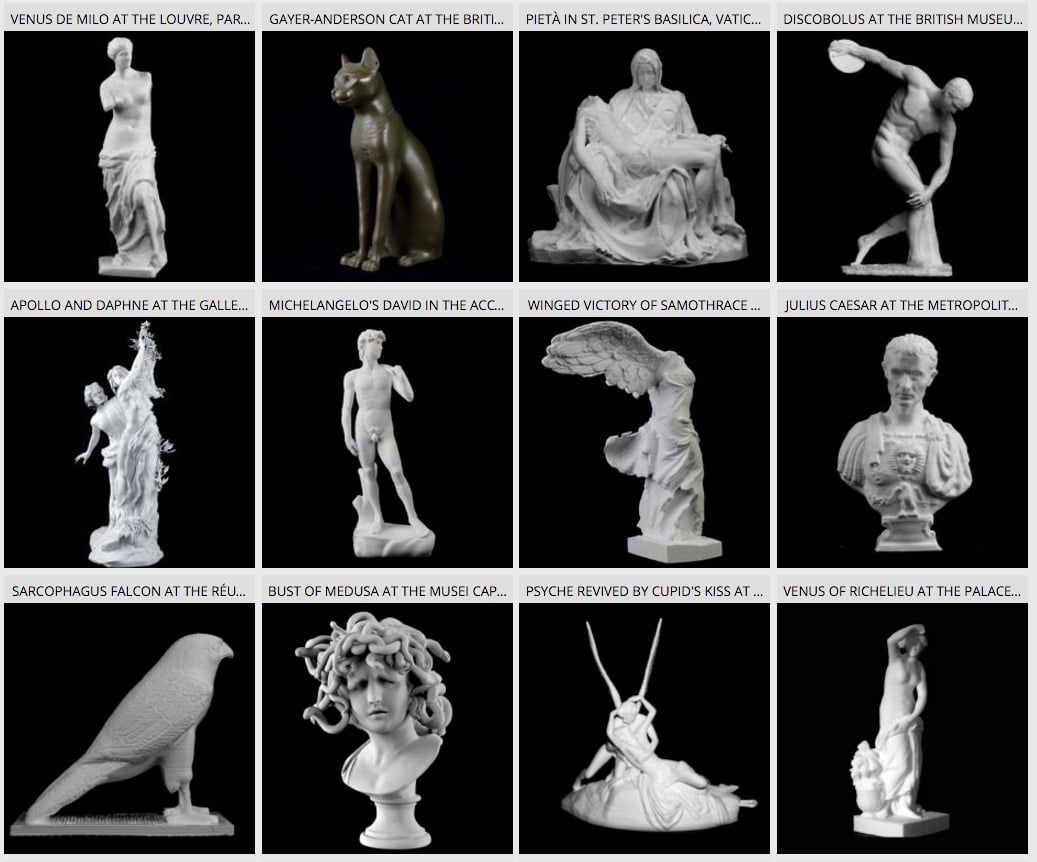
You may have read our recent series on how to properly 3D scan museum sculptures. If so, you’ll want to read the final step I forgot to include!
3D scanning sculptures is a wonderful hobby that enables you to get deeper into the priceless artwork shown at museums worldwide. Once you’ve scanned something, you know it far more intimately than a sculpture you randomly passed by in a distant museum.
But capturing such 3D scans can be quite challenging, and is often impossible for many artifacts. However, our six-part series tells you the steps necessary for success.
But there’s one thing I forgot to mention, a “Part 7”, if you will permit.
I had assumed you would be printing your scanned 3D models, but you might want to do something else: share them.
Are there places in on the Internets to share them? Plenty! Maybe too many to choose from.
There are dozens, perhaps even hundreds of 3D model sharing sites. Many will accept your 3D model without incident and permit others to download it freely, under license. Others will allow others to pay for a print of the 3D model, but before you do that, you should check with the sculpture’s owners for permission to do so.
One very good option to consider is to participate in MyMiniFactory’s non-profit “Scan The World” program. As you probably know, MyMiniFactory is one of the leading printable 3D model repositories in the world today, not only because they have many 3D models to choose from, but more importantly because they test print EVERY 3D model submitted before placing them online. This ensures each model is actually printable, unlike many other 3D model repositories.
MyMiniFactory includes a wide variety of 3D model categories, but one of them is a special project called, “Scan The World”. This initiative’s objective:
Scan The World is an ambitious initiative whose mission is to archive the world’s sculptures and landmarks in a form suitable for 3D printing. This serves to bring art and sculpture to the masses in a way more tangible than ever before, all in the wider context of meaningful contribution to education, preservation, restoration and accessibility.
Essentially, it’s a special section within MyMiniFactory that’s designed to accept and index 3D scans of museum sculptures submitted by anyone. Submissions go through the usual MyMiniFactory rigorous testing and refinement, so you can be sure all the 3,000 sculptures stored so far are of high quality.

And they want your 3D scans, too. According to Scan The World Manager Jonathan Beck:
We’re trying to encourage more from the community to pass on their raw scan data to us so that we can make it printable for them.
If you read our series and were sufficiently excited to head out to a museum and capture some ancient sculptures, you might consider uploading them to Scan The World.
There’s another reason for doing this beyond what’s mentioned above.
If you visit Scan The World, you’ll see a vast collection of high quality 3D scans of sculptures from museums around the world. In fact, they even display the locations on a real-time map.
But it’s more than just a collection: it’s literally a digital 3D museum itself! You can browse through many, many works, not only learning about them, but also downloading and printing them yourself.
This venture answers one of the vexing questions facing museums today: should they 3D scan their works and make available the resulting 3D models?
While most museums have undertaken a 3D scan project, in some cases quite extensive projects, virtually all of them do not offer the 3D scans to the public. Only in a few cases have certain museums offered access to a small number of specific 3D models.
And these are all spread out among different museum sites in ways that makes it nearly impossible for anyone to browse.
A better solution is offered by the one-stop virtual museum of Scan The World. Check it out!
Via Scan The World

